
Surgical forceps are essential instruments in any operating room, designed to grasp, hold, and manipulate tissues, vessels, or surgical materials with precision. They perform a wide range of functions, from controlling bleeding and handling delicate tissues to assisting with suturing and wound care.
A solid understanding of the different types of surgical forceps helps medical professionals select the right tool for each procedure and gives patients insight into the instruments used in their care. This article highlights the main types of surgical forceps, their specific purposes, and their applications across various medical and surgical procedures
Overview of Surgical Forceps
Surgical forceps are medical instruments designed to grasp, hold, manipulate, or retract tissues and materials with precision and minimal risk of contamination—far beyond what fingers alone can achieve. They are generally classified into two types: non-ratcheted (thumb) forceps and ratcheted (locking) forceps, each serving a specific role, whether handling delicate tissue or clamping a vessel to control bleeding.
6 Common Types of Surgical Forceps
Biopsy Forceps
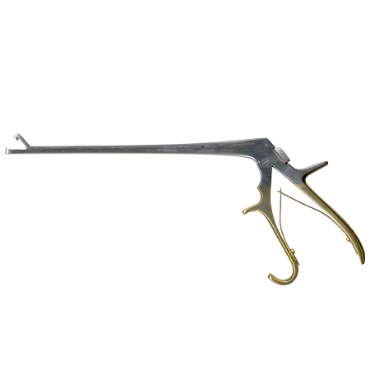
Biopsy forceps are specialized surgical instruments used to obtain tissue samples from the body for diagnostic examination, usually under a microscope. They allow doctors to collect a small piece of tissue without the need for a large incision.
Clinical Applications:
- Tissue Sampling (biopsy) – Removing small sections of tissue from organs, tumors, or lesions for pathology testing.
- Endoscopic Procedures – Commonly used with endoscopes to take samples from internal areas
- Diagnostic Accuracy – Help identify conditions such as cancer, infections, or inflammatory diseases
- Minimally Invasive Collection – Reduce trauma compared to open surgical biopsy
Ear Forceps
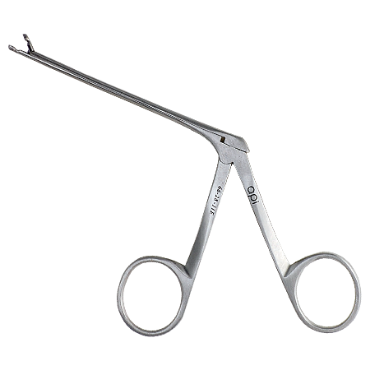
Ear forceps are specialized instruments used in otolaryngology (ENT) to grasp, hold, and remove objects or material from the ear canal. They’re designed for precision in the small, delicate space of the ear.
Clinical Applications:
- Removing foreign bodies – like beads, insects, or small objects stuck in the ear.
- Extracting earwax (cerumen impaction) when it’s too hard or deep to remove with irrigation alone.
- Placing or removing dressings/packing inside the ear canal after surgery or to control bleeding.
- Handling delicate tissue during ear surgery (e.g., tympanoplasty, myringotomy or mastoid surgery)
Hemostatic Forceps
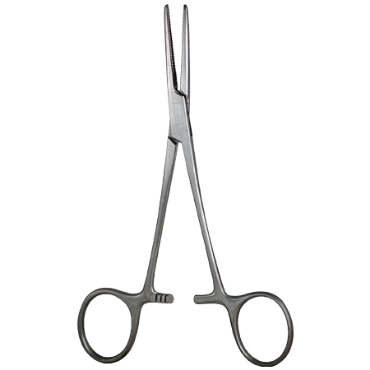
Hemostatic Forceps (often called hemostats) are surgical instruments primarily used to control bleeding during procedures. They work by clamping blood vessels or tissues to stop or reduce blood flow, making surgery safer and providing a clear operating field.
Clinical Applications:
- Mosquito Forceps – small, delicate, ideal for clamping tiny vessels.
- Kelly Forceps – larger, stronger, and better for deeper or thicker tissues. Both feature a ratcheted locking mechanism that holds them in place once applied.
- Allis Forceps – Forceps with interlocking teeth that provide a firm grip on tissue such as fascia or breast tissue. They are not gentle and can cause trauma, so they’re avoided in delicate procedures.
Nasal Forceps
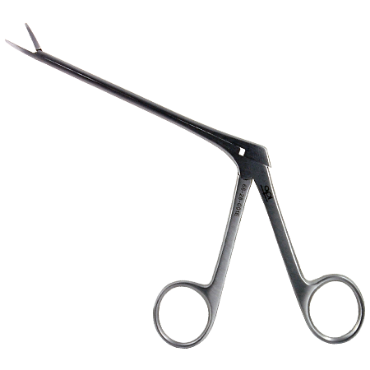
Nasal Forceps are specialized surgical instruments used to grasp, remove, or manipulate tissue and foreign bodies in the nasal cavity. They are commonly used in ENT (ear, nose, and throat) procedures are designed to give good visibility and access inside the narrow nasal cavity.
Clinical Applications:
- Removing foreign bodies – like beads or other small objects stuck in sinus cavities.
- Removing nasal polyps or grasping tissue during endoscopic sinus surgery.
- Placing or removing nasal packing/dressings after surgery or to control epistaxis (nosebleeds).
- Taking small biopsy samples of suspicious mucosa.
- Handling delicate mucosa or grafts during septoplasty, turbinate reduction, or reconstructive procedures.
Tissue & Dressing Forceps
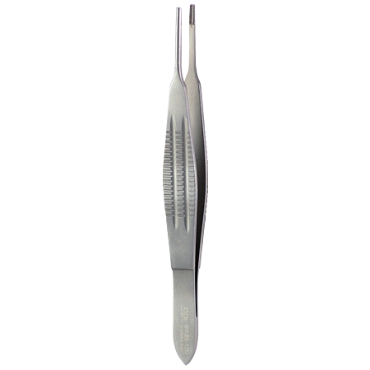
Tissue Forceps are surgical instruments shaped like tweezers but more specialized. Their main job is to grasp, hold, and manipulate tissues during medical procedures. Unlike hemostatic forceps, which clamp blood vessels, tissue forceps are mainly used to stabilize or move tissue so the surgeon can cut, suture, or examine it more easily.
Primary Uses of Tissue Forceps:
- Handling tissue during surgery – keeping skin, muscle, or organ tissue steady.
- Assisting in wound closure and suturing – holding tissue edges in place while stitches are placed.
- Manipulating skin, muscle, or organ tissue without slipping.
- Removing foreign bodies (splinters, small objects, debris).
Tissue Forceps Tip designs include:
- Toothed Tissue Forceps – grip tissue firmly (commonly used in skin closure).
- Atraumatic/Smooth Forceps – used on delicate tissues or organs to avoid tearing and reducing crush injury.
Dressing Forceps are surgical instruments primarily used for handling dressings, sponges, and other non-living materials during medical procedures. Unlike tissue forceps, they are not designed to firmly grip living tissue, but instead to assist with placing, adjusting, or removing materials in and around a wound
Primary Uses of Dressing Forceps:
- Applying and removing dressings – placing sterile gauze, bandages, or sponges on wounds.
- Handling non-tissue materials – cotton swabs, sutures, or small medical supplies in sterile fields.
- Assisting wound care – cleaning, packing, or debriding wounds with dressings or swabs.
- Occasional tissue handling – smooth or atraumatic versions may gently move tissue, but they are not meant for firm grasping.
Shop for Tissue & Dressing Forceps
Towel Clamps
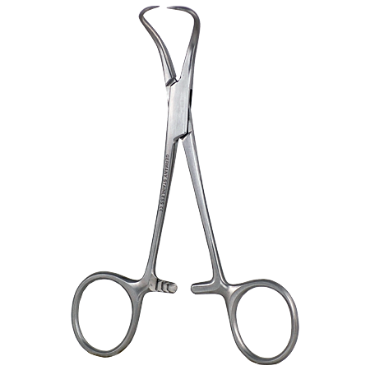
Surgical Towel Clamps are specialized instruments used to secure drapes, towels, or other sterile coverings to the patient’s skin or to each other during surgery. By holding these coverings firmly in place, towel clamps help maintain a sterile field and keep the surgical area exposed and organized.
Clinical Applications:
- Fixing surgical drapes/towels – ensuring they don’t shift during the procedure.
- Maintaining a sterile field – preventing contamination by keeping coverings stable.
- Occasional tissue holding – in some cases, towel clamps may be used to grasp tissue temporarily, such as securing skin edges or holding tissue under tension
- Instrument anchoring – sometimes used to hold small tubing or instruments in place during surgery
Specialized Surgical Forceps
Certain forceps are designed for specific medical specialties. Now, let’s focus on some specific types.
- Ophthalmic Forceps
These are ultra-fine forceps designed for precision, minimal trauma, and excellent control because eye tissues are extremely delicate. - ENT Forceps
Used in ear, nose, and throat procedures. Often long and thin, they help with the removal of foreign objects or tissue from tight spaces. The design tends to be very specialized. They allow precise handling in small, confined spaces. - Hemostatic Forceps
Used to clamp blood vessels in order to stop bleeding. They are frequently used in trauma care and surgery, and they frequently have locking mechanisms. - Plastic Surgery Forceps
Plastic surgery forceps are precision instruments for handling delicate tissues in reconstructive and cosmetic procedures, designed to minimize trauma and scarring.
How to Choose the Appropriate Forceps for Surgery
Selecting the correct forceps is essential for precision, safety, and efficiency during any procedure. Surgeons make this decision by weighing several key factors:
- Tissue Type
- Delicate tissue (skin, mucosa, vessels) – fine, atraumatic, or smooth-tipped forceps to avoid tearing.
- Dense or tough tissue (fascia, cartilage) – toothed or stronger forceps for a secure grip.
- Delicate tissue (skin, mucosa, vessels) – fine, atraumatic, or smooth-tipped forceps to avoid tearing.
- Surgical Goal
- Grasping or stabilizing tissue – thumb (non-ratcheted) forceps.
- Clamping a vessel or controlling bleeding – hemostatic (ratcheted) forceps.
- Assisting suturing or wound closure – tissue or Adson-type forceps.
- Size and Shape
- Forceps vary in length, width, and tip design (curved, straight, serrated, or smooth).
- Surgeons choose based on the anatomy being accessed and the need for precision vs. strength.
- Procedure Type
- Plastic or reconstructive surgery – micro or atraumatic forceps for fine tissue handling.
- General surgery – versatile, robust forceps suited to multiple tasks.
- ENT or nasal procedures – long, slender, often curved forceps for confined spaces.
- Surgeon Preference & Experience
- Comfort, tactile feedback, and familiarity often guide the final choice.
- Sterility & Compatibility
- The selected forceps must be sterilizable and compatible with the surgical set or specific instruments being used.
Understanding the differences between forceps, knowing when to use each type, and keeping them well-maintained all contribute to safer, more efficient surgeries.
Wrapping Up
So there you have it—from everyday dressing and hemostatic forceps to the more specialized instruments used in ophthalmology and ENT, surgical forceps are far more varied and essential than they might seem at first glance.
Understanding the distinctions between forceps, selecting the right type for each situation, and ensuring proper maintenance all play a vital role in achieving safe, effective surgical outcomes.
FAQs
What are the most common types of surgical forceps?
Dressing forceps, hemostatic forceps (like Mosquito or Kelly), and tissue forceps (such as Adson and Debakey) are used in most general procedures.
What is the difference between hemostatic and tissue forceps?
Hemostatic forceps are used to clamp blood vessels and control bleeding, featuring locking handles for a secure grip. Tissue forceps are designed to grasp and manipulate delicate tissues without locking, often with smooth or toothed tips to prevent damage. In essence, hemostats focus on bleeding control, while tissue forceps focus on precision handling of tissue.
Are surgical forceps reusable?
Yes, most surgical forceps are reusable, but only when properly cleaned, disinfected, and sterilized between uses. They are typically made of stainless steel or other durable metals that can withstand repeated sterilization cycles.

